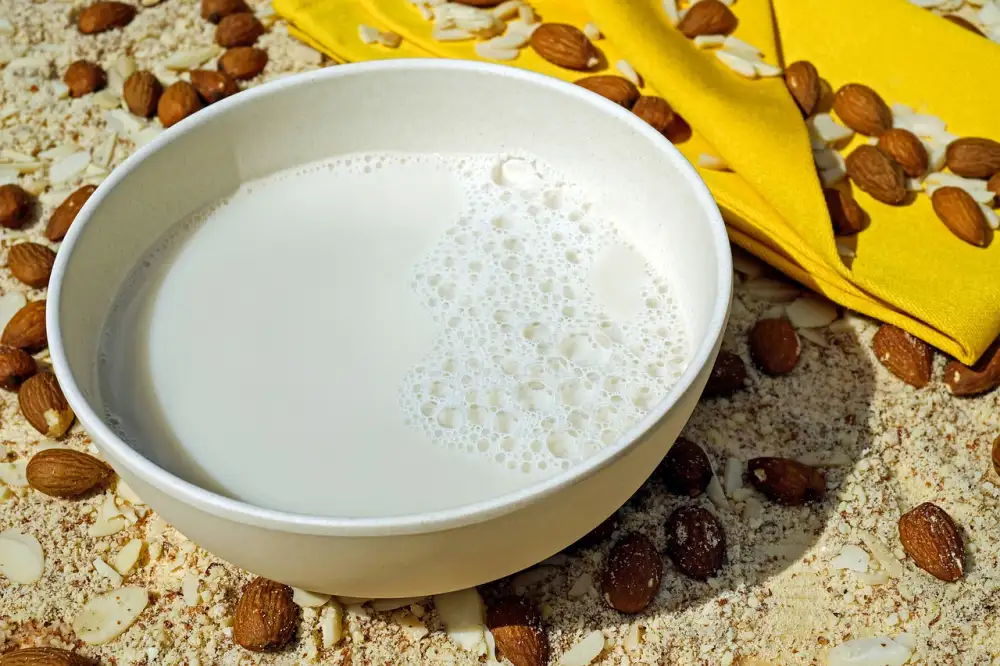Unveiling the Shelf Life Secrets: Does Almond Milk Go Bad? Find Out the Spoilage Signs and Ensure Your Health

- Understanding the Shelf Life of Almond Milk
- Factors that Affect Shelf Life
- Typical Shelf Life of Unopened Almond Milk
- Shelf Life of Opened Almond Milk
- Signs of Spoilage in Almond Milk
- Visual Indicators
- Smell Test
- Texture Changes
- Proper Storage and Handling of Almond Milk
- Refrigeration Guidelines
- Avoiding Contamination
Almond milk has gained popularity as a dairy-free alternative, loved for its creamy texture and nutty flavor. But have you ever wondered about its shelf life? How long can you keep that carton of almond milk before it goes bad? In this article, we will delve into the secrets of almond milk's shelf life, understanding the factors that affect it, and learning how to spot signs of spoilage. By following proper storage and handling practices, you can ensure the freshness and enjoyment of your almond milk. So let's unravel the mysteries and discover how to make the most out of this nutritious beverage!
Understanding the Shelf Life of Almond Milk
Almond milk, a popular alternative to dairy milk, has a limited shelf life like any other perishable product. Several factors can affect its shelf life, including the quality of ingredients used, the packaging method, and storage conditions.
Unopened almond milk typically has a longer shelf life compared to opened almond milk. On average, unopened almond milk can last up to several months past its expiration date if stored properly in a cool and dry place. However, it is crucial to check the label for specific instructions as different brands may have varying recommendations.
Once opened, almond milk should be consumed within a week or two. This is because exposure to air and bacteria can lead to spoilage and potential health risks. It is essential to keep track of when you opened the container and ensure that it is tightly sealed after each use.
Understanding these factors will help you make informed decisions about consuming almond milk and avoid any potential health risks associated with spoiled products.
Factors that Affect Shelf Life
The shelf life of almond milk can be influenced by several factors. One important factor is the processing method used. Almond milk that has undergone ultra-high temperature (UHT) pasteurization tends to have a longer shelf life compared to those that have been minimally processed.
Another factor is the packaging. Almond milk packaged in aseptic cartons or bottles with airtight seals can last longer than those in open containers. The packaging material also plays a role, as light-sensitive packaging can help extend the shelf life by protecting the milk from harmful UV rays.
Additionally, the quality of the almonds used and any added preservatives or additives can affect shelf life. Almond milk made from fresh, high-quality almonds and without any artificial ingredients tends to have a shorter shelf life compared to those with added preservatives.
It's important to note that proper storage and handling also play a crucial role in maintaining the freshness and extending the shelf life of almond milk. By understanding these factors, you can ensure that your almond milk stays fresh and safe for consumption.
Typical Shelf Life of Unopened Almond Milk
The typical shelf life of unopened almond milk can vary depending on various factors. Generally, commercially packaged almond milk has a shelf life of about 1 year when stored properly. However, it is important to check the expiration date on the packaging for accurate information. It is also crucial to note that homemade almond milk may have a shorter shelf life and should be consumed within 3-4 days.
Shelf Life of Opened Almond Milk
Once you've opened a carton of almond milk, its shelf life will be significantly shorter than when it was unopened. On average, opened almond milk can last for about 7-10 days in the refrigerator. However, this can vary depending on various factors such as the brand, storage conditions, and how well it has been sealed after opening. It is important to check for signs of spoilage before consuming to ensure your health and safety.
Signs of Spoilage in Almond Milk
When it comes to almond milk, it is important to be aware of the signs of spoilage to ensure your health and enjoyment. Here are some indicators that your almond milk may have gone bad:
Visual Indicators: If you notice any clumps, curdling, or separation in the almond milk, it is a clear sign that it has spoiled. Additionally, if there are any mold growth or discoloration present, it is best to discard the milk.
Smell Test: Give your almond milk a sniff before consuming. If you detect a sour or off-putting odor, it is likely that the milk has turned and should not be consumed.
Texture Changes: Pay attention to any changes in texture. If the almond milk appears lumpy or slimy, it is a strong indication of spoilage and should be discarded.
By being vigilant and recognizing these signs of spoilage, you can ensure that you consume fresh and safe almond milk for maximum enjoyment.
Visual Indicators
One of the easiest ways to determine if almond milk has gone bad is by checking for visual indicators. Fresh almond milk should have a smooth and creamy consistency, with a uniform color throughout. If you notice any clumps, separation, or curdling, it is a clear sign that the almond milk has spoiled.
Additionally, look out for any mold growth on the surface of the almond milk. Mold can appear as green, black, or white spots and should never be consumed. If you see any signs of mold, it's best to discard the entire container to avoid any potential health risks.
Remember to always give your almond milk a quick visual inspection before consuming it to ensure its freshness and quality.
Smell Test
The smell test is another effective way to determine if almond milk has gone bad. When you open the container, take a whiff of the milk. Fresh almond milk should have a mild, slightly nutty aroma. If you detect any sour or unpleasant smell, it is a clear indication that the milk has spoiled. Trust your nose and discard it immediately to avoid any potential health risks. Remember, consuming spoiled almond milk can lead to food poisoning and other digestive issues.
Texture Changes
Another important indicator of spoilage in almond milk is changes in its texture. When almond milk goes bad, it may become clumpy or develop a slimy consistency. These changes occur due to the growth of bacteria or mold in the milk.
If you notice any lumps or a slimy texture when pouring almond milk, it is a clear sign that it has spoiled and should not be consumed. Consuming spoiled almond milk can lead to food poisoning and other health issues.
To ensure the freshness and quality of your almond milk, always check for any unusual texture changes before consuming it.
Proper Storage and Handling of Almond Milk
a. Refrigeration Guidelines
To ensure the freshness and longevity of almond milk, it is crucial to store it properly. Unopened almond milk should always be kept in a cool and dry place, away from direct sunlight. However, once opened, it must be refrigerated at all times. The cold temperature of the refrigerator helps slow down the growth of bacteria and extends the shelf life of almond milk.
b. Avoiding Contamination
To prevent contamination, it is essential to handle almond milk with clean hands and utensils. Always make sure to seal the container tightly after each use to minimize exposure to air and potential contaminants. Additionally, avoid using a dirty or wet spoon when scooping out almond milk as this can introduce unwanted bacteria into the liquid.
By following these storage and handling guidelines, you can ensure that your almond milk stays fresh for longer periods, allowing you to enjoy its creamy goodness without worrying about spoilage or compromising your health.
Refrigeration Guidelines
Proper refrigeration is essential for maintaining the freshness and quality of almond milk. Once opened, it should be promptly stored in the refrigerator at a temperature between 32°F (0°C) and 40°F (4°C). It is important to seal the container tightly to prevent any air or odors from contaminating the milk. Additionally, ensure that the almond milk is not placed near strong-smelling foods, as it can absorb their flavors. Remember to always check the expiration date and discard any almond milk that has passed its shelf life. By following these refrigeration guidelines, you can prolong the shelf life of your almond milk and enjoy it at its best.
Avoiding Contamination
To avoid contamination and ensure the freshness of your almond milk, it is important to follow proper handling practices. Firstly, always wash your hands before handling the container or pouring the milk. This helps prevent any bacteria from transferring onto the milk. Secondly, make sure to use clean utensils when scooping or pouring almond milk. Dirty utensils can introduce harmful bacteria into the milk. Additionally, avoid cross-contamination by not using the same utensils for other dairy products. Lastly, never drink directly from the container as this can introduce bacteria from your mouth into the almond milk. By following these guidelines, you can enjoy fresh and uncontaminated almond milk for a longer period of time.
In conclusion, understanding the shelf life of almond milk is crucial for ensuring its freshness and enjoyment. By being aware of the factors that affect shelf life and following proper storage guidelines, you can extend the lifespan of your almond milk.
Remember to always check for visual indicators of spoilage such as discoloration or curdling. Additionally, trust your sense of smell to detect any off-putting odors. Lastly, pay attention to any changes in texture, as this can also be a sign of spoilage.
To maximize the shelf life of unopened almond milk, store it in a cool and dry place away from direct sunlight. Once opened, refrigerate it promptly and consume within 7-10 days.
Proper handling is also important to avoid contamination. Always use clean utensils when pouring almond milk and never drink directly from the container.
By following these guidelines, you can ensure that your almond milk remains fresh and safe for consumption. So go ahead and enjoy this nutritious dairy alternative without worrying about its spoilage!
Published: 08. 01. 2024
Category: Food



